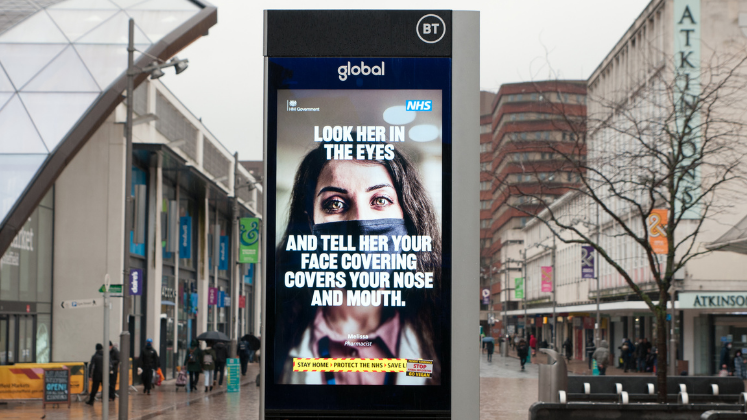The use of nudge theory to inform policy interventions in response to COVID-19 has re-opened debates over the politically paternalistic nature of governing by ‘nudges’ and has given momentum to calls to include the more participatory elements of co-design into policymaking. Emma Blomkamp and Colette Einfeld suggest in seeking to combine mutually exclusive elements of each practice, academics and policymakers risk blurring lines of authority and public trust in policymaking.
The COVID-19 pandemic has by necessity renewed interest in innovative approaches to policymaking. Notably in two areas, nudge and co-design. Nudges were used to encourage social distancing in India and elsewhere. Co-design has been promoted as a way to improve public trust in policy responses to the pandemic in the UK, Canada and Australia. Elements of each approach were also brought together to promote handwashing in Bangladesh. Increasingly, academics and practitioners are calling for nudge and co-design to be used together.
Both nudge and co-design promise more effective outcomes for governments by taking into account the public’s ‘real’ behaviour, to overcome biases in traditional top-down approaches to policymaking. However, as we explore in our recent paper, both approaches stem from different understandings of society and politics. This raises questions over whether in practice these approaches are compatible and complementary in policy design, or contradictory to the extent they could undermine trust in government.
Both nudge and co-design promise more effective outcomes for governments by taking into account the public’s ‘real’ behaviour, to overcome biases in traditional top-down approaches to policymaking.
Nudge is an approach to public policy that changes the context in which decisions are presented to citizens in order to encourage a particular choice. To illustrate, a nudge might change the presentation of information in letters sent to dangerous drivers, aiming to increase payment of the fine and reduce reoffending. This nudge would likely then be tested using a Randomised Control Trial.
Co-design uses creative and participatory methods to engage citizens, stakeholders and officials in an iterative process to respond to shared problems. If we again use the example of road safety, a co-design approach might start by reviewing literature and data, then use this knowledge to inform a range of design, research and decision-making activities with a co-design group. The co-design group could bring together community representatives, drivers targeted by the policy, government stakeholders and experts. Options for policy implementation would be generated, tested and reshaped in an iterative process with the co-design group.
Nudge and co-design have been used in the areas of obesity, tax compliance and road safety. Our examples above are based on instances of co-design in New Zealand and nudge in the UK. Both approaches use experimentation, are seen to reflect real world behaviour, and address wicked problems.
A recent academic article claims it is possible and desirable to “co-design behavioural public policy”. The Nudge Unit at an American University and a New Zeal#and health authority claim to have co-designed nudges in healthcare. The Behavioural Insights Team in the UK are also co-designing nudges, as part of their recent work encouraging STEM careers for women.
Whether these examples strictly adhere to nudge and co-design principles is debatable. Despite calling its approach a ‘design lab’, there was no evidence of designerly practice in the recently published case study of ‘co-designing nudges’, which was led by an academic research and policy team. An American Medical Association article on designing nudges refers to “stakeholder co-design”, although the top-down communication process it describes is far from what is normally considered as co-design.
The appeal of co-designing nudges stems from criticisms of paternalism in nudge theory. Nudges are arguably inherently paternalistic, since experts are making decisions about which choice will make the individual better off. Governments then guide people to the decision without public consultation. For advocates, co-design offers the potential to reintroduce different perspectives and an element of shared power into the policymaking process. This enthusiasm for combining these approaches makes it a good time to encourage reflection on whether they can be used together.
We argue that the underlying logic and philosophy of co-design and nudge are contradictory. Informed by the radical roots of participatory design, co-design techniques aim to deliberately flatten hierarchies, include more diverse forms of knowledge and experience in the policymaking process, and increase the agency of the people most affected by a policy. Nudge, on the other hand, promotes a different model of state-citizen relations. Advocates of the approach argue that people do not always make good decisions, and so it is government’s role to “steer” them towards the desired behaviour. Nudge approaches privilege quantitative and scientific evidence, whereas co-design also embraces lived experience and creative expression.
To effectively combine nudge and co-design, a policymaker needs to simultaneously see themselves as an expert who has the authority to guide how others should behave, as well as not impose their views on others, seeing people as the experts in their own lives. This muddling of authority and expertise could potentially add to confusion on the role of government and exacerbate declining trust in experts and institutions.
To effectively combine nudge and co-design, a policymaker needs to simultaneously see themselves as an expert who has the authority to guide how others should behave, as well as not impose their views on others, seeing people as the experts in their own lives.
Let us take the example of road safety again, and imagine trying to “co-design a nudge”, illustrating some of the questions and contradictions to consider. In the process, a policymaker may draw on academic evidence on how to reduce speeding, and take this to a co-design group, presenting them with potential nudges to explore. The statistical, population-level evidence on the causes of road safety brought to the co-design group may conflict with the diverse lived experiences of group members. The policymaker then has to decide if they are the expert in selecting evidence, or if people are the experts in their experiences. They would also need to decide whether to test one selected intervention through an RCT or adapt numerous lower fidelity prototypes through an iterative user testing and development process.
Further, the co-design group may contest the problem framing, reframe it as a structural rather than behavioural issue, and/or suggest an alternative response, such as community-led initiatives, rather than a nudge aiming to steer people towards a particular behaviour. Does the co-design group have the status and space to challenge, not only the solution and whether nudges are the most appropriate intervention, but also the policymakers’ understanding of the problem? If nudge is the predetermined policy tool, but co-designers expect to be able to shape the output, might this undermine the process and trust in the government?
This example demonstrates that, while nudge and co-design have similarities, when applied together, their underlying assumptions and philosophies can cause conflict and contradictions. We hope that, by critically reflecting on the differences and similarities in approaches such as co-design and nudge, researchers and practitioners can use and evaluate policymaking methods and tools with a greater awareness of their implications for policy effectiveness and political trust.
This post draws on the authors’ paper, Nudge and co-design: complementary or contradictory approaches to policy innovation?, published in Policy Studies.
Note: This article gives the views of the authors, and not the position of the LSE Impact Blog, nor of the London School of Economics. Please review our comments policy if you have any concerns on posting a comment below.
Image Credit: Adapted from Marriane Bos, via Unsplash.









3 Comments